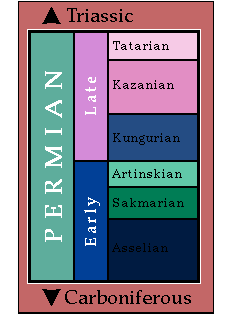The Permian
290 to 248 Million Years Ago
The Permian period lasted from 290 to 248 million years ago and was the
last period of the Paleozoic Era.
The distinction between the Paleozoic and the Mesozoic is made at the end
of the Permian in recognition of the largest mass extinction recorded in
the history of life on Earth. It affected many groups of organisms in
many different environments, but it affected marine communities the most
by far, causing the extinction of most of the marine invertebrates of the time.
Some groups survived the Permian mass extinction in greatly diminished numbers,
but they never again reached the ecological dominance they once had,
clearing the way for another group of sea life. On land, a relatively
smaller extinction of diapsids and synapsids cleared the way for other
forms to dominate, and led to what has been called the
"Age of Dinosaurs".
Also, the great forests of fern-like plants shifted to
gymnosperms, plants with their
offspring enclosed within seeds. Modern conifers, the most familiar
gymnosperms of today, first appear in the fossil record of the Permian.
In all, the Permian was the last of the time for some organisms
and a pivotal point for others, and life on earth was never the same again.
The global geography of the Permian included massive areas of land and water.
By the beginning of the Permian, the motion of the Earth's crustal plates had
brought much of the total land together, fused in a supercontinent known as
Pangea. Many of the continents of today in somewhat intact form met
in Pangea (only Asia was broken up at the time), which stretched from the
northern to the southern pole. Most of the rest of the surface area of the
Earth was occupied by a corresponding single ocean, known as Panthalassa, with a smaller sea to the east of Pangea known as Tethys.
Models indicate that the interior regions of this vast continent were probably
dry, with great seasonal fluctuations, because of the lack of the moderating
effect of nearby bodies of water, and that only portions received rainfall
throughout the year. The ocean itself still has little known about it.
There are indications that the climate of the Earth shifted at this time,
and that glaciation decreased, as the interiors of continents became drier.
Click on the buttons below to learn more about the Permian.


 |
Subdivisions of the
Permian:
The chart at left shows the major subdivisions of the Permian Period.
Use the arrows to back to the Carboniferous, or go forward to the
earliest Mesozoic Era, the Triassic Period.
The Permian Period is part of the
Paleozoic Era.
|
Find out more about the Permian paleontology and geology of North America at the Paleontology Portal.








